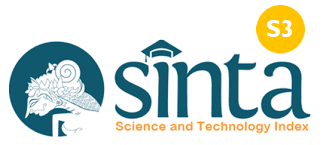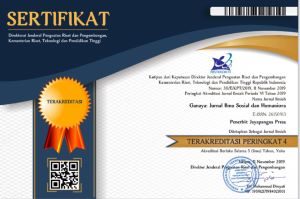The Educational Relations and Agrarian Life Orientation in the Majapahit Period
DOI:
https://doi.org/10.37329/cetta.v5i3.1852Keywords:
Majapahit, Education, Agrarian, MaritimeAbstract
The Majapahit Kingdom is one of the major Hindu-Buddha kingdoms in the Nusantara. The kingdom that has been around for a long time certainly has a lot of history that deserves to be studied, such as the education system, and the system of economic life. Both certainly have an inseparable relationship, between education and the agrarian system of life. The purpose of this study was to determine the relationship between non-formal education and agrarian life in the Majapahit kingdom, both in terms of the economic system and knowledge of the people at that time in their agrarian life, besides that the purpose of this study was to educate readers about informal education. During the Majapahit era and its relationship with the orientation of the agrarian life of the Majapahit kingdom, this discussion is expected to further broaden the reader's insight into the history of the Nusantara. This study uses qualitative methods and historical data collection in order to describe an event, social activity, thought, belief either individually or in groups. As for the results obtained from this study, the Majapahit kingdom was an agrarian kingdom, where the economic sector was in the agricultural sector. The technology used in agriculture has existed since ancient times, but it is still simple. Based on the discussion with this method, we come to a conclusion that, Majapahit was a very developed kingdom in its time, both in terms of education and agrarian life and the relationship between the two was very closely related.
References
Ali, I., & Sulistiyono, S. T. (2020). A Reflection of “Indonesian Maritime Fulcrum” Initiative: Maritime History and Geopolitical Changes. Journal of Maritime Studies and National Integration, 4(1), 12–23.
Ali, I., Sulistiyono, T., & Supriatna, E. (2021). Memertabatkan Semula Sejarah Maritim Sebagai Suatu Disiplin Dan Cadang Ilmu Dalam Mendepani Perkembangan Semasa Ilmu Kelautan Modern. Jurnal Kemaritiman: Indonesian Journal of Maritime, 2(2), 68-93.
Anwari, I. R. M. (2015). Sistem Perekonomian Kerajaan Majapahit. VERLEDEN : Jurnal Kesejarahan, 3(2), 104–115.
Ayuhanafiq, Gani, R. A., & Sudyar, E. (2020). Kumpulan Cerita Majapahit. Pustaka.Dispendik.Mojokertokab.Go.Id, 125.
Christiana, E. (2013). Pendidikan yang Memanusiakan Manusia. Humaniora, 4(1), 398-410.
Efendi, N. (2014). Peran Bengawan Solo Pada Perekonomian Majapahit Abad XIV-XVI. Avatara, 2(3).
Fatmawati, I. (2015). Efektivitas Buah Maja (Aegle Marmelos (L.) Corr.) sebagai Bahan Pembersih Logam Besi. Jurnal Konservasi Cagar Budaya, 9(1), 81–87.
Haryono, T. (1997). Kerajaan Majapahit: Masa Sri Rajasanagara sampai Girindrawarddhana. Humaniora V, 107–113.
Isno. (2015). Pendidikan Islam Masa Majapahit dan Dakwah Syekh Jumadil Kubro. Jurnal Pendidikan Agama Islam, 03(01), 9–25.
Kaswati, A., Hapsari, N., & Amalina, J. A. (2020). Analisis Sistem Pendidikan Pada Jaman Kerajaan Sriwijaya-Majapahit Dan Jaman Modern Dalam Kaitannya Dengan Peradaban Bangsa Indonesia. Akademika;Jurnal Ilmiah Kependidikan, 19(1), 65–79.
Khasanah, L. I., & Wisnu. (2017). Pelabuhan Kambang Putih Pada Masa Majapahit Tahun 1350-1389. Avatara, 5(2), 402–417.
Marlina, S., & Herlina, N. (2021). Upaya Peningkatan Pendidikan, Keahlian Dan Profesionalisme Sumber Daya Manusia Pelayaran Indonesia. Jurnal Ilmiah M-Progress, 11(2), 107–116.
Munandar, A. A. (2009). Majapahit: Kerajaan Agraris-Maritim di Nusantara. Universitas Indonesia, 37–72.
Noor, A. M., & Wibisono, W. (2017). Tritangtu ( Pola Tiga ) Dalam Ani-Ani ( Alat Potong Padi ). Jurnal Teknologi, 7(1), 1–8.
Noviandi, Amsia, T., & Ekwandari, Y. S. (2015). Perang Paregreg Pada Masa Pemerintahan Wikramawardhana Terhadap Poleksosbud Dan Hankam Kerajaan Majapahit. PESAGI: Jurnal Pendidikan Dan Penelitian Sejarah, 3(4), 1–12.
Nurkholis. (2013). Pendidikan dalam Upaya Memajukan Teknologi Pendidikan. Jurnal Kependidikan, 1(1), 24–44.
Pradana, Y. (2017). Bangunan Keagamaan Pada Masa Pemerintahan Rakai Watukura Dyaḥ Balitung ( 898-910 M .). Amerta: Jurnal Penelitian Dan Pengembangan Arkeologi, 35(1), 47–60.
Rizqianto, M. B., Wartoyo, F. X., & Wibowo, S. (2021). Situs Kepurbakalaan Majapahit Di Wilayah Gunung Penanggungan Sebagai Sumber Pembelajaran Sejarah Lokal. STKIP PGRI Sidoarjo.
Safitri, S. (2015). Telaah Geomorfologi Kerajaan Majapahit. Jurnal Criksetra, 4(7), 57–61.
Sanjoyo, M. P. (2020). Canggu: Pelabuhan Sungai Masa Majapahit Abad Xiv – Xvi. MOZAIK Jurnal Ilmu-Ilmu Sosial Dan Humaniora, 10(2).
Santiko, H. (2012). Agama Dan Pendidikan Agama Pada Masa Majapahit. Jurnal AMERTA, Jurnal Penelitian Dan Pengembangan Arkeologi, 30(2), 128.
Subroto, P. (1985). Sistem pertanian tradisional pada masyarakat Jawa tinjauan secara arkeologis dan etnografis. Pelita, 1–104.
Tanudirjo, D. A. (2014). Inspirasi Majapahit. Yogyakarta: PT Intan Sejati.
Wahyudi, D. Y. (2013). Kerajaan Majapahit : Dinamika dalam Sejarah Nusantara. Sejarah Dan Budaya, 7(1), 88–95.
Wahyudi, D. Y., Sujud, S., Munandar, A. A., & Soesanti, N. (2014). Pusat Pendidikan Keagamaan Masa Majapahit. Jurnal Studi Sosial, 6, 109.
Wibowo, W. (2017). Kemaritiman Indonesia: Sebuah Kajian Kritis. Jurnal Manajemen Transportasi Dan Logistik, 4(2), 211.
Zalukhu, I. P., & Jurahman, Y. B. (2020). Sumbangan Kerajaan Majapahit Dalam Bidang Pemerintahan Dan Kehidupan Sosial Budaya Di Nusantara Inta. AKADEMIKA: Jurnal Ilmiah Kependidikan, 19(2), 1–8.
Downloads
Published
How to Cite
Issue
Section
License
Copyright (c) 2022 Rieca Nona Mutia, Nara Shakti Salsabillah, LR Retno Susanti, Dedi Irwanto

This work is licensed under a Creative Commons Attribution-ShareAlike 4.0 International License.
An author who publishes in the Cetta : Jurnal Ilmu Pendidikan agrees to the following terms:
- Author retains the copyright and grants the journal the right of first publication of the work simultaneously licensed under the Creative Commons Attribution-ShareAlike 4.0 License that allows others to share the work with an acknowledgement of the work's authorship and initial publication in this journal
- Author is able to enter into separate, additional contractual arrangements for the non-exclusive distribution of the journal's published version of the work (e.g., post it to an institutional repository or publish it in a book) with the acknowledgement of its initial publication in this journal.
- Author is permitted and encouraged to post his/her work online (e.g., in institutional repositories or on their website) prior to and during the submission process, as it can lead to productive exchanges, as well as earlier and greater citation of the published work (See The Effect of Open Access).
Read more about the Creative Commons Attribution-ShareAlike 4.0 Licence here: https://creativecommons.org/licenses/by-sa/4.0/.





